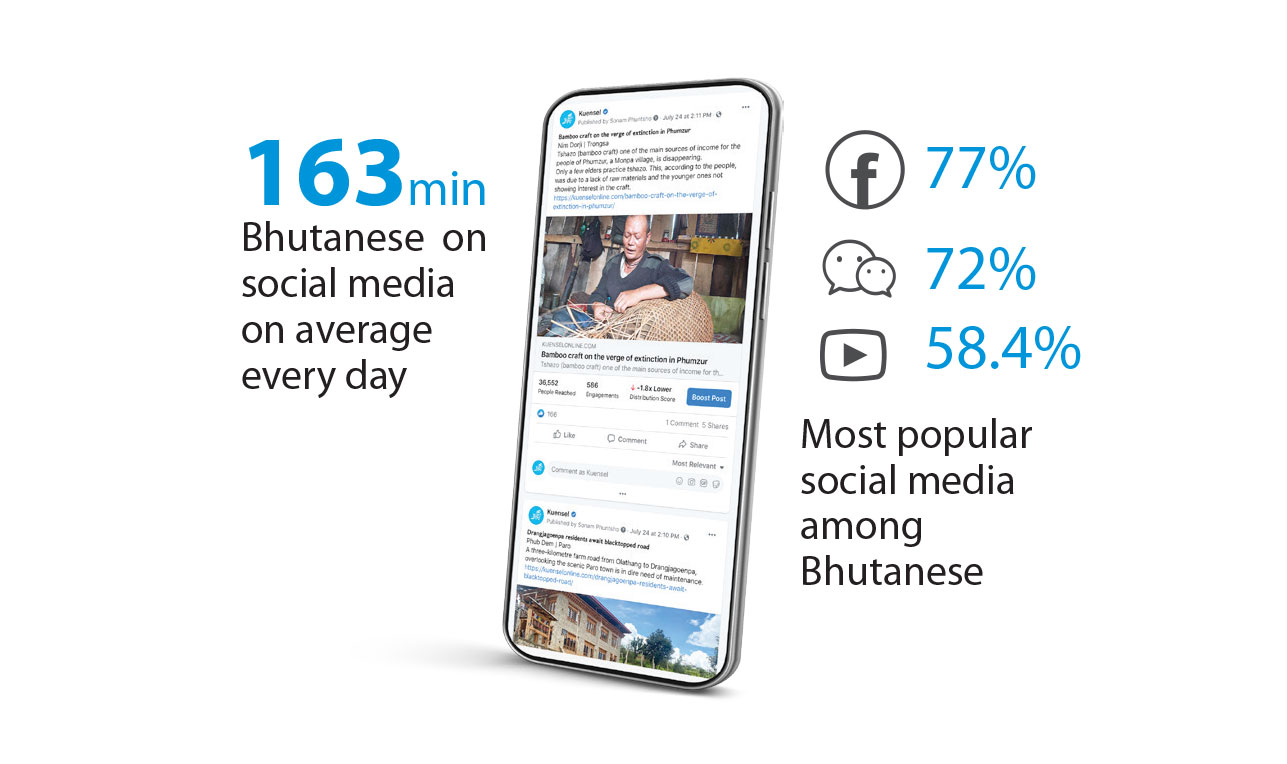Chhimi Dema
It started as a friendly conversation on Messenger.
Pema, 24, said that she thought her old schoolmate was being friendly, asking about her job and life.
“After chatting for three weeks, he asked me to send him nudes. When I denied, he started sending his nudes,” she said.
It was not just pictures, Pema said. Her friend even wrote her lewd text messages.
“I was disturbed. I was afraid to check my phone whenever I got notifications. I blocked him on the Facebook. That made me feel better,” she said.
Often people misuse and fall prey to scams on social media.
In 2018, a man posted a topless photograph of his former girlfriend on Facebook. The court convicted the 36-year-old man to prison for a year and was made to pay the victim.
According to a study conducted by the Bhutan Media Foundation, Social Media Landscape in Bhutan, about 38 percent of social media users reported having received spam and indecent posts one or more times; 16 percent of users reported getting trolled; 12 percent reported hacking; and having fallen prey to scams.
The study stated: “Limited knowledge and awareness about ethical, privacy and safety issues, and increasing incidences of exposure to insidious or negative content, social media users may be highly vulnerable to negative experiences and cybercrime.”
About 50 percent of social media users may be highly vulnerable to privacy and security threats, about 35 percent may be moderately vulnerable, and 15 percent may be at low risk, according to the study.
The survey was conducted last year and beginning of this year.
The study aims to generate data on the usage and understanding of social media in Bhutan.
The survey was based on 1,244 respondents and representatives from 26 government, private and civil society organisations.
According to the study, on average, Bhutanese spend about three hours (163 minutes) every day on social media, higher than the estimated global average (145 minutes).
The study showed that 90.5 percent of the respondents were members of at least one social media platform, suggesting that the social media penetration rate in Bhutan is “very high”.
The social media penetration rate in urban areas is 96 percent and 87.6 percent in rural areas. About 91.5 percent of men and 89.5 percent of women were active social media users.
Sonam Wangmo, 24, a corporate employee, said that she has seven social media accounts on different platforms.
“I use them to chat with my friends and update on current happenings,” she said, adding that she spends more than two hours on social media platforms.
According to the study, a regular employee spends the highest time (more than four hours a day) on social media. An unemployed individual and students spend more than three hours every day.
“The findings that employees (regularly paid and casual) tend to be the most intensive users of social media suggests they may also be doing at the expense of their other engagements, including during working hours,” according to the study.
The survey showed that 73.6 percent of Bhutanese log into their social media account before they sleep, and 43.6 percent of people check social media the first thing when they wake up. The study also showed that, on average, Bhutanese spend Nu 936 in a month on the internet.
Seeking information, entertainment, socialisation, dissemination information and education were the top five purposes of the use of social media in Bhutan, stated the study.
Many Bhutanese use social media to look for houses and sell anything from clothes to pots and pans.
About 83 percent of the survey respondents said that imposition of some restrictions or advocacy programmes were necessary to reduce the excessive use of social media.
The study recommends designing training and awareness programmes to advocate on social media ethics and promote its safe, secure and socially desirable use. “The government may consider developing an overarching National Social Media Strategy which would seek to guide the social media use in the country as a tool to strengthen the relevant domains of Gross National Happiness (such as time use and community vitality) and mitigate adverse effects.”
Edited by Jigme Wangchuk


